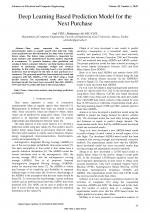| 2/2020 - 5 |
Deep Learning Based Prediction Model for the Next PurchaseUTKU, A. |
| Extra paper information in |
| Click to see author's profile in |
| Download PDF |
Author keywords
time series analysis, deep learning, prediction, e-commerce
References keywords
series(26), time(25), neural(19), forecasting(16), networks(12), learning(11), prediction(9), arima(9), network(8), deep(8)
Blue keywords are present in both the references section and the paper title.
About this article
Date of Publication: 2020-05-31
Volume 20, Issue 2, Year 2020, On page(s): 35 - 44
ISSN: 1582-7445, e-ISSN: 1844-7600
Digital Object Identifier: 10.4316/AECE.2020.02005
Web of Science Accession Number: 000537943500005
SCOPUS ID: 85087459081
Abstract
Time series represent the consecutive measurements taken at equally spaced time intervals. Time series prediction uses the information in a time series to predict future values. The future value prediction is important for many business and administrative decision makers especially in e-commerce. To promote business, sales prediction and sensing of future consumer behavior can help business decision makers in marketing campaigns, budget and resource planning. In this study, deep learning based a new prediction model has been developed for the time of next purchase in e-commerce. The proposed model has been extensively tested and compared with RF, ARIMA, CNN and MLP using a retail market dataset. The experimental results show that the developed model has been more successful than RF, ARIMA, CNN and MLP to predict the time of the next purchase. |
| References | | | Cited By |
Web of Science® Times Cited: 6 [View]
View record in Web of Science® [View]
View Related Records® [View]
Updated today
SCOPUS® Times Cited: 14
View record in SCOPUS® [Free preview]
View citations in SCOPUS® [Free preview]
[1] A Brief Survey of Machine Learning and Deep Learning Techniques for E-Commerce Research, Zhang, Xue, Guo, Fusen, Chen, Tao, Pan, Lei, Beliakov, Gleb, Wu, Jianzhang, Journal of Theoretical and Applied Electronic Commerce Research, ISSN 0718-1876, Issue 4, Volume 18, 2023.
Digital Object Identifier: 10.3390/jtaer18040110 [CrossRef]
[2] A Hybrid Deep Learning-Metaheuristic Model for Diagnosis of Diabetic Retinopathy, GÜRCAN, Ömer Faruk, ATICI, Uğur, BEYCA, Ömer Faruk, Gazi University Journal of Science, ISSN 2147-1762, Issue 2, Volume 36, 2023.
Digital Object Identifier: 10.35378/gujs.919572 [CrossRef]
[3] Artificial intelligence in customer retention: a bibliometric analysis and future research framework, Singh, Chetanya, Dash, Manoj Kumar, Sahu, Rajendra, Kumar, Anil, Kybernetes, ISSN 0368-492X, Issue 11, Volume 53, 2024.
Digital Object Identifier: 10.1108/K-02-2023-0245 [CrossRef]
[4] Transformer-Based Model for Predicting Customers’ Next Purchase Day in e-Commerce, Grigoraș, Alexandru, Leon, Florin, Computation, ISSN 2079-3197, Issue 11, Volume 11, 2023.
Digital Object Identifier: 10.3390/computation11110210 [CrossRef]
[5] An Empirical Study on Software Test Effort Estimation for Defense Projects, Cibir, Esra, Ayyildiz, Tulin Ercelebi, IEEE Access, ISSN 2169-3536, Issue , 2022.
Digital Object Identifier: 10.1109/ACCESS.2022.3172326 [CrossRef]
[6] A Personalized Product Design and Recommendation System Using LSTM for Enhanced User Shopping Behavior Analysis, Liu, Lu, Zhang, Lei, Journal of Circuits, Systems and Computers, ISSN 0218-1266, 2025.
Digital Object Identifier: 10.1142/S021812662550327X [CrossRef]
[7] Machine Learning-based Prediction Mechanism of Repeated Purchase Behavior of E-commerce Customers, Li, Shuyuan, 2024 IEEE 4th International Conference on Electronic Communications, Internet of Things and Big Data (ICEIB), ISBN 979-8-3503-6072-1, 2024.
Digital Object Identifier: 10.1109/ICEIB61477.2024.10602662 [CrossRef]
[8] Data Mining and Prediction Algorithms for Takeout Purchase Behavior, Li, Ying, 2024 International Conference on Industrial IoT, Big Data and Supply Chain (IIoTBDSC), ISBN 979-8-3315-3981-8, 2024.
Digital Object Identifier: 10.1109/IIoTBDSC64371.2024.00049 [CrossRef]
[9] Prediction Model of User Purchase Behavior Based on Machine Learning, Zhai, Xiang, Shi, Peng, Xu, Liang, Wang, Yalong, Chen, Xi, 2020 IEEE International Conference on Mechatronics and Automation (ICMA), ISBN 978-1-7281-6416-8, 2020.
Digital Object Identifier: 10.1109/ICMA49215.2020.9233677 [CrossRef]
Disclaimer: All information displayed above was retrieved by using remote connections to respective databases. For the best user experience, we update all data by using background processes, and use caches in order to reduce the load on the servers we retrieve the information from. As we have no control on the availability of the database servers and sometimes the Internet connectivity may be affected, we do not guarantee the information is correct or complete. For the most accurate data, please always consult the database sites directly. Some external links require authentication or an institutional subscription.
Web of Science® is a registered trademark of Clarivate Analytics, Scopus® is a registered trademark of Elsevier B.V., other product names, company names, brand names, trademarks and logos are the property of their respective owners.
Faculty of Electrical Engineering and Computer Science
Stefan cel Mare University of Suceava, Romania
All rights reserved: Advances in Electrical and Computer Engineering is a registered trademark of the Stefan cel Mare University of Suceava. No part of this publication may be reproduced, stored in a retrieval system, photocopied, recorded or archived, without the written permission from the Editor. When authors submit their papers for publication, they agree that the copyright for their article be transferred to the Faculty of Electrical Engineering and Computer Science, Stefan cel Mare University of Suceava, Romania, if and only if the articles are accepted for publication. The copyright covers the exclusive rights to reproduce and distribute the article, including reprints and translations.
Permission for other use: The copyright owner's consent does not extend to copying for general distribution, for promotion, for creating new works, or for resale. Specific written permission must be obtained from the Editor for such copying. Direct linking to files hosted on this website is strictly prohibited.
Disclaimer: Whilst every effort is made by the publishers and editorial board to see that no inaccurate or misleading data, opinions or statements appear in this journal, they wish to make it clear that all information and opinions formulated in the articles, as well as linguistic accuracy, are the sole responsibility of the author.



